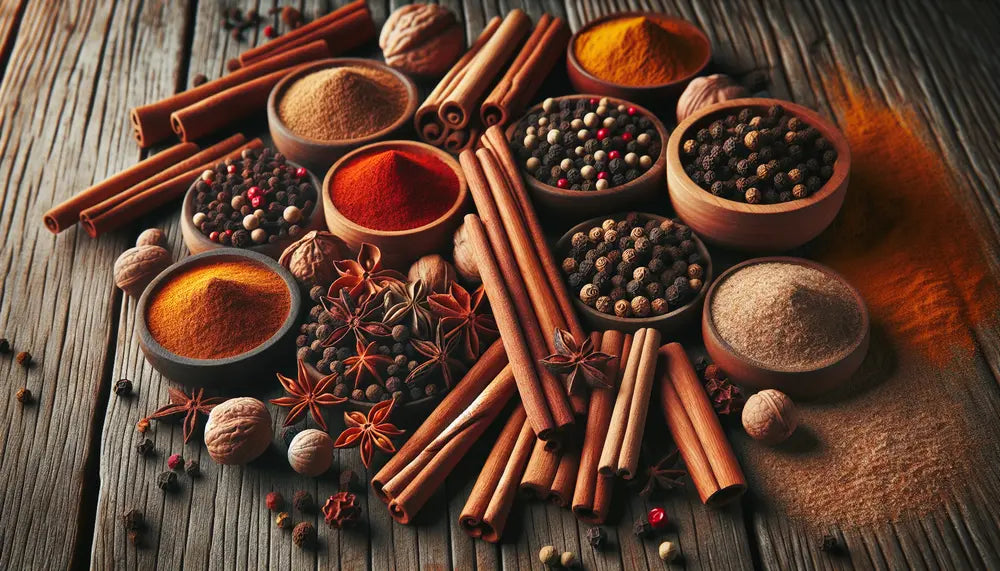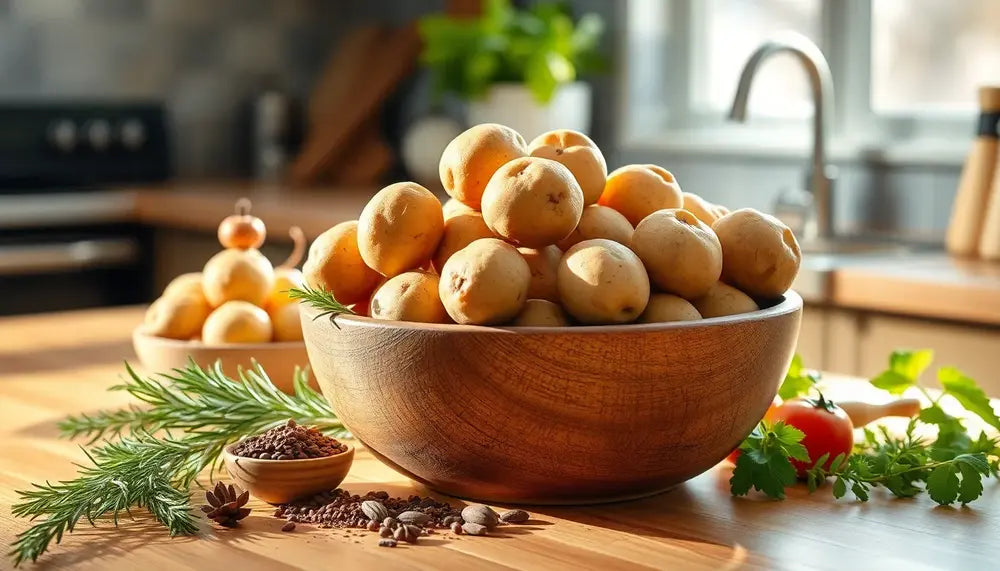Why the quality of spices is crucial
The quality of spices plays a crucial role in the taste and aroma of your food. High quality spices can do that Cooking experience significantly enrich and give the finished meal an incomparable touch. But it's not just about the taste. The quality also directly affects the Health Benefits from what spices can offer.
Another important aspect is that Security. Poor quality spices can be used pollutants contaminated by mold or pesticide residues. Such contamination can not only affect the taste and the aromatic properties of the spices, but also pose health risks.
Therefore, it is crucial to maintain high standards and choose trustworthy sources when purchasing spices. Investing in quality spices not only protects your health but also improves yours culinary creations.
Identifying characteristics of high-quality spices
To high quality spices There are several ways to distinguish them from inferior ones Identifying featuresthat you should pay attention to. Play first color and texture an important role. Fresh, high-quality spices usually have a bright, strong color and a consistent, fine texture without clumping.
Another important feature is the smell. High-quality spices are characterized by a strong, characteristic scent that should be easily noticeable. The scent should appear clear and fresh, not musty or stale.
- Aroma: Intense and defined scent when opening the packaging.
- Packaging: Airtight packaging helps to preserve the aromatic oils and thus the aroma of the spices.
- Graininess: The graininess should be uniform, with no visible foreign bodies or impurities.
After all, it can Labeling Be insightful: Manufacturers of high-quality spices often provide detailed information about the origin of the spices, the harvest date and even tips on how to best use them.
Origin and cultivation: influence on spice quality
The Origin and the type of cultivation have a significant influence on the quality of the spices. Spices from traditional growing areas, which are known for their special climate conditions and soil conditions, often offer outstanding quality.
For example, the world-famous Malabar pepper from India known for its intense aroma, which is influenced by the region's specific rain patterns and rich soil. Likewise, Madagascar is known for its high quality Vanilla known, whose cultivation requires special care and complex pollination processes.
| spice | Country of origin | Special features in cultivation |
|---|---|---|
| Turmeric | India | Traditional farming methods without artificial fertilizers |
| Saffron | Iran | Hand-picked saffron threads, gentle drying |
Furthermore, the type of cultivation influences the sustainability and ecological impact of spice production. Organic cultivation that avoids the use of chemical pesticides can not only improve the quality of the spices, but also protects the environment.
Processing and storage: key factors for freshness
The type of Processing and Storage plays a crucial role in maintaining the freshness and aromatic qualities of Seasoning. Gentle processing that takes place quickly after harvest is essential to preserve the natural oils and flavors in the spices.
When drying spices, for example, a low temperature is crucial. Excessive heat can destroy the essential oils that give the spices their aroma. Many high-quality spice manufacturers therefore rely on air drying under shady conditions to ensure quality.
- Low temperature drying: Preserves the oils and therapeutic properties.
- Shade drying: Avoid direct sunlight, which can degrade the flavors.
- Gentle grinding: Maintains consistency and protects against overheating.
Storing spices is equally critical. You should in hermetically sealed containers stored to minimize contact with air and moisture. Light and heat can also be harmful, so a cool, dark place is ideal for storage. The correctness of these conditions can be illustrated by the following formula:
Freshness (t) = e-k·t
Whereby k the rate of quality loss over time t represents, and e is the basis of natural logarithms.
Organic vs. conventional: Differences in spice quality
The decision between Organic- and conventional spices can have a significant impact on quality and environmental impact. Organic spices are grown without the use of synthetic pesticides or chemical fertilizers. This not only protects the environment, but can also help ensure that the spices are purer and of higher quality.
Conventional spices, on the other hand, have the possibility of containing residues of chemicals used during cultivation and processing. Not only can these substances be potentially harmful to health, but they can also affect the natural flavor of the spices.
| Organic spices | Conventional spices | |
|---|---|---|
| Cultivation | Without synthetic pesticides | Use of chemicals possible |
| Health aspects | Lower risk from chemicals | Possible pesticide residues |
| aroma | Tendency towards more intense, natural flavors | Potential exposure to chemicals |
Overall, these factors often lead to organic spices being considered the higher quality choice be viewed. This is reinforced by the trend that more and more consumers are attaching importance to healthy eating and environmentally friendly products.
Tips for buying high-quality spices
When purchasing high quality spices there are some important tips that can help you choose the best products. These tips are crucial to ensuring you get genuinely high-quality spices that will enhance your cooking experience.
- Check sources: Buy spices from trusted retailers or brands known for their quality and transparency.
- Origin information: Make sure you provide clear information about the origin of the spices. Spices from certain regions are often known for their excellent quality.
- Packaging: Prefer spices in airtight sealed packaging. These protect against moisture and loss of aromas.
- Visual evaluation: Check the color and texture of the spices. They should look fresh and vibrant, with no signs of fading or moisture.
- Expiry date: Check the expiry date printed on it. Fresher spices offer better aroma and flavor.
A good guideline for the freshness of spices can be done mathematically using the formula Freshness (t) = A-k·t be expressed, where A the initial quality, k the rate of decline over time t and e is the basis of natural logarithms. This formula illustrates how quickly spices can lose their quality.
A conscious choice of spices can make a real difference in your dishes. Take the time to select quality spices and experience the flavor boost in your kitchen.
The role of certifications and seals
Certifications and seals play a crucial role when purchasing Seasoning, as they help consumers understand the quality and origin of products. These seals ensure that the spices have been produced, processed and traded according to certain standards, which creates trust.
This is a widely used certificate Organic seal, which indicates that the spices were grown without synthetic pesticides and artificial fertilizers. This seal is not only an indicator of health standards, but also signals environmentally friendly production.
- Fairtrade: This seal guarantees that spice farmers receive fair prices for their products and work under fair working conditions.
- Rainforest Alliance: Indicates that the cultivation of the spices supports environmentally sound practices that contribute to the preservation of biodiversity and the protection of natural resources.
- GMO-free: Guarantees that the spices are free of genetically modified organisms.
In addition to those mentioned above, there are many other certificates that indicate specific aspects such as pesticide-free cultivation or regional origin. When buying spices you should always pay attention to these seals. These support the mathematical formula of quality assurance, Q = S E, where Q stands for quality, S for the standards guaranteed by certifications and seals, and E compliance with these standards.
The presence and variety of such certifications in a spice product can go a long way toward providing peace of mind that you are making a conscious and responsible choice.
How to spot fake spices
The market for spices Unfortunately, this can also be affected by counterfeit products that are sold as high quality but are not. However, there are some signs that can help you fake spices to recognize.
First you should go to the Price pay attention. If a spice is offered at a significantly lower price than the market average, this could be an indicator of poor quality or counterfeiting. High-quality spices are usually more expensive due to the careful cultivation and processing methods.
- Check packaging: Counterfeit spices can often be found in poorly made or defective packaging that does not clearly state information such as origin and expiration date.
- Smell and color: Fake spices may have a faint or unusual smell. The color may be pale or uneven, indicating the addition of low-quality fillers or dyes.
- Consistency: An uneven consistency or visible contamination can also indicate a counterfeit.
Finally, it is advisable to buy spices from specialized or well-known retailers if possible and, if in doubt, purchase a small quantity for a quality check before purchasing larger quantities. Knowing the expected appearance and aroma of specific spices can also help you identify counterfeits, ensuring you're getting real quality for your money.
These checks can be formalized into the formula Authenticity (A) = P V G be expressed, where P for the price, v for packaging and G stands for smell and color.
Practical storage tips for long-lasting aromas
Around the Flavors Yours spices To preserve it for a long time, proper storage is essential. Here are practical tips to ensure your spices retain their freshness and flavor.
- Dark and cool storage: Store your spices in a cool, dark cupboard. Light, heat and moisture can quickly break down the aromas.
- Airtight containers: Use airtight containers to store your spices. This prevents air and moisture from penetrating and affecting quality.
- Prefer glass vessels: Glass is non-porous and retains flavors better than plastic or metal. You can also easily check the contents and remaining quantity.
- Labeling: Label your spice containers with the date purchased or opened. Spices have a limited shelf life, and clear labeling helps keep track of them.
- Avoiding cross-contamination: Always use clean spoons or knives to remove spices from their containers. This prevents food residue or moisture from getting into the spices.
These storage techniques can be achieved by the formula Storage quality (LQ) = V2 · S · K are represented, where v for packaging efficiency, S for the cleanliness of the removal and K stands for the preservation contribution of dark and cool conditions. By following these tips, you can effectively maximize and prolong the quality and flavor of your spices.
Conclusion: Investing in quality is worth it
In conclusion it can be said that the investment in high quality spices definitely worth it. Both in relation to taste of your dishes as well as for you Health Quality spices make a significant difference.
By choosing spices with Certifications, which guarantee sustainable and chemical-free production, you not only contribute to the health of your family, but also support ethical farming practices worldwide. Furthermore, proper storage allows you to enjoy the full potential of the flavors of your spices over a longer period of time.
Conscious selection and careful care of your spices not only brings you culinary excellence, but also represents responsible behavior that respects the producer and the environment. The formula for long-term enjoyment and sustainability could be: Quality Gain (QG) = A B C, where A for choosing the best spices, b for conscious purchasing decisions and C ensures correct storage.
Therefore, invest in spices that not only enrich your kitchen but also make a positive contribution to the world. The added value that high-quality spices provide is definitely worth the investment.
FAQ: Recognizing the quality of spices
What makes a high-quality spice?
A high-quality seasoning is characterized by an intense aroma, bright color and a fresh, consistent texture without lumps. In addition, no artificial additives or fillers should be used, and the packaging should protect the aroma well.
How does the origin influence the quality of spices?
The origin of a spice is crucial, as climatic conditions and soil conditions can significantly influence the aromas and quality. Spices from traditional growing areas known for their quality are often of higher quality.
Why is the type of processing relevant to the spice quality?
The processing technique is important to preserve the natural flavors and oils. Gentle drying and correct grinding are crucial, as too much heat and mechanical stress can destroy the flavors.
What role do packaging and storage play in maintaining the quality of spices?
The packaging should be airtight to prevent moisture and air from entering, which can reduce flavors. Cool, dark storage also helps preserve quality and freshness over time.
What should you consider when buying spices to ensure high quality?
When buying, you should pay attention to the origin, the harvest date and the type of processing. Choose products from trusted suppliers who offer transparency into their production and sourcing processes. Also check the expiration date and the integrity of the packaging.





Share:
Optimal selection: Order spices online and enjoy
Spice quality test: Which brands impress in the taste test?